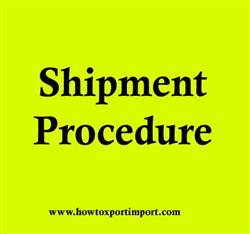Shipment Procedure
Export cargo can be exported to the overseas buyer by sea, air or land. However, shipment by sea is the most popular and generally resorted to, as it is comparatively cheaper. Besides, the ship's capacity is far greater than other modes of transportation. Nevertheless, transportation by air is utilized for export of expensive items like, diamonds, gold, etc. The shipment stage includes the following steps:
(a) Reservation of shipping Space: Once the export contract is finalised, the exporter reserves the required space in the vessel for shipment. On accepting the exporter's request, the shipping company issues a shipping Order. The original copy of the shipping order is given to the exporter and the duplicate is sent to the commanding officer of the ship. The shipping order is an instruction by the shipping company to the commanding officer of the ship that  the goods as per the details given should be received on board.
the goods as per the details given should be received on board.
(b) Arrangement of Internal Transportation up to the Port of Shipment: The exporter makes necessary arrangements for transportation of goods to the port either by road or railways. On loading goods into the railway wagon, the railway authorities issue a 'Railway Receipt', which may be either 'freight paid' or freight to pay'. It serves as a title to the goods. The exporter endorses the railway receipt in favour of his agent to enable him to take delivery of the goods at the port of shipment.
(c) Preparation and Processing of Shipping Documents: As the goods reach the port of shipment, the exporter should issue detailed instructions to the C&F agent for the shipment of cargo along with a complete set of the documents listed below:
Letter of Credit along with the export contract or export order.
Commercial Invoice (2 copies)
Packing List or Packing Note.
Certificate of Origin.
GR Form (original and duplicate)
ARE-1 Form.
Certificate of Inspection, where necessary (original copy)
Marine Insurance Policy.
(d) Customs Clearance: The cargo must be cleared from the Customs before it is loaded on the ship. For this, the above mentioned documents, along with five copies of shipping bill, are to be submitted to the Customs Appraiser at the Customs House. The Customs Appraiser ensures that all the formalities relating to exchange control, quality control, pre-shipment inspection and licensing have been complied with by the exporter. After verification, all documents, except the original GR, original copy of Shipping Bill and one copy of Commercial Invoice, are returned to the C&F agent.
(e) Obtaining 'Carting Order' from the Port Trust Authorities: The C&F agent, then, approaches the Superintendent of the concerned Port Trust for obtaining the 'Carting Order' for moving the cargo inside the dock. After obtaining the Carting Order, the cargo is physically moved into the port area and stored in the appropriate shed.
(f) Customs Examination and Issue of 'Let Export Order': The Customs Examiner at the port of shipment physically examines the goods and seals the packages in his presence. The same can be arranged for at the factory or warehouse of the exporter by making an application to the Assistant Collector of Customs. The Customs Examiner, if satisfied, issues a formal permission for the loading of cargo on the ship in the form of a Let. Export Order'.
(g) Obtaining 'Let Ship Order' from the Customs Preventive Officer: 'Let Export Order' must be supplemented by a 'Let Ship Order' issued by the Customs Preventive Officer. The C&F agent submits the duplicate copy of Shipping Bill, duly endorsed by the Customs Examiner, to the Customs Preventive Officer who endorses it with the 'Let Ship Order'.
(h) Obtaining Mate's Receipt and Bill of Lading: The goods are then loaded on board the ship for which the Mate or the Captain of the ship issues Mate's Receipt to the Port Superintendent. The Port Superintendent, on receipt of port dues, hands over the Mate's Receipt to the C&F Agent. The C&F Agent surrenders the Mate's Receipt to the Shipping Company for obtaining the Bill of Lading. The Shipping Company issues two to three negotiable and two to three non-negotiable copies of Bill of Lading.
Import General Manifest (IGM)
Importance of Bill of Lading
Introduction to this web site.
Is Airway bill a documents of title?
Is Customs House Agents (CHA ) required to be appointed mandatory?
Transferability of Bill of Lading
Transhipment - A redefinition
Travelers to India under import duty exemption, Frequently Asked Questions Part 2
Triangular export
Triangular shipment
Types of Insurance Documents.
Is DP terms of payment safe in export business?
Is Letter of Credit LC safe for an Importer?
Is ON BOARD CERTIFICATE required for LC negotiation
Who can inspect import cargo in US
Who decides shipping carrier on FOB shipments
Who gets benefits from this website?
Who is a ‘Manufacturer’ of excisable goods
Who is a prime banker to check authenticity of letter of credit?
Who is Stevedores
Who receives the amount of auctioned / resold imported unclaimed/un-cleared goods?
Why demurrage/detention waiver period is required at destination for importTransferability of Bill of Lading
Why do carriers balance weight and volume while charging freight amount in Exports?
How does CENVAT Credit work?
Why, best attention while preparing Export Invoice?
Is Letter of Credit LC safe for an Importer?
Is ON BOARD CERTIFICATE required for LC negotiation
What is said to contain in Bill of Lading.